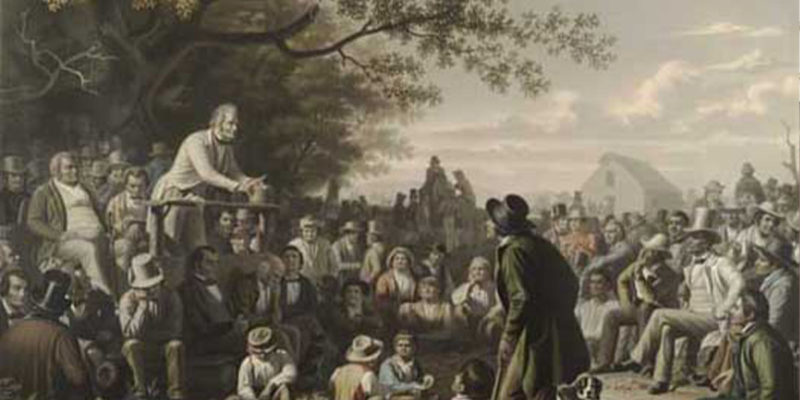Originalism best reflects the Founding Fathers’ faith in self-government and also best preserves the legitimacy of the U.S. Supreme Court.
The Founding Fathers dreamed of an America where government was of the people, by the people, and for the people. Therefore, the Framers vested the power to create laws in an elected legislature alone. As Federalist 78 indicates, they tasked the judiciary with exercising judgment rather than force or will. The most important consideration before the Supreme Court when determining the constitutionality of a law ought to be whether such a law would have been considered constitutional at the time of the adoption of the Constitution and the amendments to it. I argue that examining what the Founders meant and interpreting the Constitution’s text according to the original public meaning of its words (also known as Originalism) is the most legitimate manner for the Court to proceed. This mode of interpretation checks the power of the judiciary, and represents the triumph of self-government.
Beginning with Dredd Scott v. Sanford, which created “substantive due process,”—and was openly defied by President Lincoln – court decisions on controversial issues inconsistent with the original understanding of the Constitution have threatened the legitimacy of the Court. The violent upheaval that followed Roe v. Wade; the open defiance of Obergefell v. Hodges by many, including County Clerk Kim Davis, Senators Ted Cruz and Rick Santorum, and Governor Mike Huckabee; the ongoing practice of displaying the Nativity on state property during Christmas; and the recitation of prayers in public schools in defiance of the Court’s decision exemplify substantial threats to the Court’s legitimacy. Most importantly, the fact that every Republican Presidential nominee since Ronald Reagan has publicly opposed Roe vs. Wade is evidence that the Court is akin to a political player in the fray with organized political parties. All of this, I argue, is the consequence of deviating from Originalism.
The chief argument in defense of Originalism is not that it is perfect, but that it beats all competition, including its chief rival: the Living Constitution theory. Originalism has its drawbacks. Invariably judges must decide how to apply the provisions of the Constitution to new phenomena such as new technology. Furthermore, the natural law and the positivist approaches to Originalism may create division among Originalists themselves, especially, when the original public meaning of the text of the Constitution cannot be fully discerned—resulting in Originalists, themselves, drawing different conclusions. For instance, narrow (e.g., Justices Scalia and Thomas; Robert P. George) rather than expansive (e.g., Michael McConnell) interpretations of the original Free Exercise clause of the First Amendment are evidence of division within the Originalist framework (see Employment Division v. Smith). Even amidst these divisions, however, all Originalists agree on where to look for answers, which is to say in the original public meaning of the words. Originalists never advocate rendering new meaning to old provisions. Most importantly, Originalism sees the Constitution as a legal text to be interpreted in the context in which it was written, and not as an evolving and changing organism capable of spewing out brand new rights and liberties as deemed needed by a majority of nine unelected judges. Originalism does not invite unelected judges to interpret laws based on their personal views; it primarily relies on historical inquiry, and not moral philosophy.
Despite the aforementioned conflicts within Originalism, answers to most of the controversial cases are crystal clear. Contrary to popular opinion, there’s no right to privacy mentioned anywhere in the Constitution. The majority in Griswold v. Connecticut was right to conclude that the First, Third, Fourth, and Fifth amendments can be construed to protect people’s privacy on certain occasions. However, they set a bad precedent in creating a penumbra of other rights including an additional judicially enforceable blanket right to privacy, allowing the federal judiciary to strike down democratically passed laws prohibiting contraception, abortion, and homosexual sodomy, all of which laws had been considered perfectly consistent with the Constitution for nearly two centuries. Furthermore, the ratifiers of the Fourteenth Amendment never understood its text to contain any hidden homosexual marriage clause, only to be discovered by five unelected judges after more than a century. In fact, Justice Kennedy himself emphasized in both Hollingsworth v. Perry, and, subsequently, in United States v Windsor that the “regulation of domestic relations is an area that has long been regarded as a virtually exclusive province of the States” and that “the Federal Government, through our history, has deferred to state-law policy decisions with respect to domestic relations” (Kennedy, United States v Windsor). He has abided by such reasoning only when Originalist arguments could plausibly favor the outcomes he supported in those cases. For instance, Kennedy changed his reasoning in Obergefell v. Hodges, applying his own version of the natural law to impose the Court’s definition of marriage upon all fifty states.
On another controversial issue, the Establishment Clause was placed in the First Amendment to preserve state prerogative, not to confer upon the Federal Judiciary the right to disestablish state-established churches. At the time of the adoption of the Bill of Rights, six of the founding colonies had state-established churches, one of which lasted well into the late 1820’s. They were all disbanded not by Congress, but by the states themselves by their own choice. Nobody believed that state-established churches violated the Establishment Clause. Some attempt to argue that based upon the Fourteenth Amendment’s incorporation doctrine, the First Amendment could be applied against the states. Nonetheless, the Establishment Clause, just like the Tenth Amendment, was adopted to preserve a state prerogative. As such, even if the rest of the Bill of Rights could be incorporated, it is incoherent to apply against a state a clause which was placed to protect said state’s rights.
Moreover, even at the national level, the Establishment clause was meant to prevent Congress from establishing a national church—like England has the Anglican Church. The Framers never called for neutrality between religion and non-religion. Indeed, liberal justices often appeal to a so-called “impregnable and high wall of separation.” However, this so-called separation is not rooted in Constitutional tradition but in secular propaganda. The Declaration of Independence, without which there would be no Constitution, mentions the Supreme Being no less than four times, refers to a “firm reliance on Providence’” on which this country was built, and explicitly states that our inalienable rights come not from Congress but from our Creator. Even Jefferson, after mentioning the so-called wall of separation for the first time in his letter to the Danbury Baptists, kept attending church on Capitol Hill—whose use as a church on Sunday was authorized through a Congressional Act in December 1800. Fisher Ames recommended the reverent study of the Bible for school children, and James Madison declared that our Constitution was made for a moral and “religious” people: these were the co-authors of the First Amendment. If anything, what the Founders required of the Establishment Clause was that the national government refrain from establishing a national church, and perhaps remain neutral between various denominations. As opposed to what some secular activists demand, it was not a call for the national government trample upon Ethical Monotheism and promote Atheistic secularism.
Originalism prevents judges from deciding cases based upon their personal preferences. It must be acknowledged that Originalism is, and rightly so, often associated with conservatism. Hence, many are inclined to believe that Originalist judges render decisions based on their ideological preferences as well. However, one must understand that some of the foundational principles of the United States embodied in the Constitution and the accompanying founding documents were by modern standards conservative principles involving values such as limited government, states’ rights, a belief in Ethical Monotheism, and the individual citizens’ right to bear arms. That judges’ own political views are aligned with America’s founding values does not justify the conclusion that such judges are deciding cases merely based upon their own political beliefs. In fact, on many occasions, Originalist interpretations have led Originalist judges to decide cases against their personal views. In Texas v. Johnson, Justice Scalia voted in favor of flag burning, which aligned with his judicial philosophy on the Free Speech Clause and went against his personal condemnation of the practice.
Originalism preserves and promotes the best of American democracy. The Employment Division v. Smith decision shocked many across the political spectrum who feared that the court had read religious liberty out of the Constitution. However, the decision resulted in uniting the Right and the Left, bringing together a broad coalition ranging from the ACLU to Rev. Jerry Falwell’s Moral Majority in defense of religious liberty. Subsequently, the Religious Freedom Restoration Act, proposed in the House by then Congressman Chuck Schumer and spearheaded in the Senate by the late Ted Kennedy, passed almost unanimously. President Bill Clinton, who called religious liberty the first of all freedoms, signed the bill into law to the applause of the entire nation. Despite many successes like this, one may argue that leaving certain issues up to the legislatures creates gridlock, and that settling problems through the Court is the best option when legislatures seem to get nowhere. Gridlock, however, despite its drawbacks, was embraced by the Founding Fathers as a far more tolerable alternative to dictatorial tyranny. In fact, the process of creating legislation was meant to be difficult so that after thorough dialogue the best ideas would prevail. Critics might also argue that unless the Court makes certain decisions the rights of minorities are at risk. However, democracy, by definition, means rule by the majority. In a liberal democracy like the United States, the majority itself has decided through the Bill of rights to protect certain explicitly stated rights from being usurped through simple majorities. If one is not satisfied with such a view, the solution is not to make false claims about new rights that can be read out of old texts, but to take action—as did the Northerners who fought a war against the Confederacy to pass the Thirteenth Amendment and set the captives free.
What made possible the enduring legacy of an exceptional America was the Founding Fathers’ faith in an unprecedented experiment in self-government whereby “We the People” through our Constitution could govern ourselves. Originalism sees that Constitution—that American promise—as a covenant to be protected rather than an organism to be molded. Hence, it is Originalism that best upholds the legitimacy of the Court; best preserves the dream of the Founders; and best protects the promise of future generations.




 Compass is an online journal that provides a space for the work of talented undergraduates who have original and well-articulated insights on important ideas and issues relating to American democracy understood in the broad contexts of political philosophy, history, literature, economics, and culture.
Compass is an online journal that provides a space for the work of talented undergraduates who have original and well-articulated insights on important ideas and issues relating to American democracy understood in the broad contexts of political philosophy, history, literature, economics, and culture.